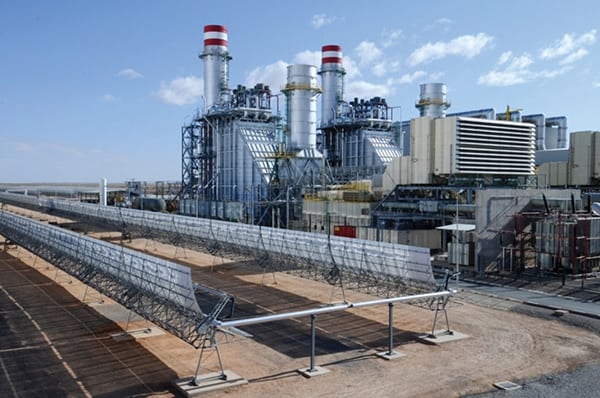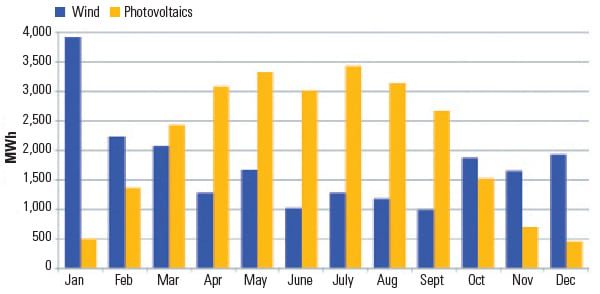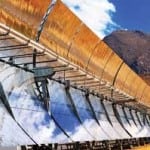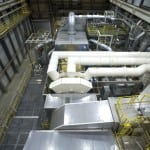Everyone loves efficiencies. Combining generation technologies can create a plant that’s more than the sum of its parts, but engineering challenges mean these projects are not for the faint of heart.
When you think of “hybrids” these days, your first thought is probably of automobiles. But hybrids—hybrid power plants, that is—are starting to emerge in the power sector as well.
Co-locating different types of generation on the same site is far from a new idea. Where an existing plant has the space, it’s typically far simpler and less expensive to build on the unused land rather than a greenfield site. Many large coal- and gas-fired thermal plants have a few combustion turbines intended for peaking duty parked in a corner of their lot.
What is a new trend is combining generation resources with the intent of using their respective performance characteristics to compensate for each other’s shortcomings—to essentially create a plant that’s more than the sum of its parts and that can do more than the two resources acting independently.
The impetus for this new trend is the enormous increase in wind and solar generation over the past decade and the degree to which the intermittency of wind and sunlight has become an area of concern for generators and grid operators. With other generators being called upon to compensate for fluctuating output from wind farms and solar plants, plant developers have begun looking at ways of combining resources to reduce this intermittent output. (Note: This article will not address examples where small amounts of renewable generation have been added to large fossil plants, as these are not true hybrids.)
Solar + Gas: Bringing the Heat
The combination that is probably furthest along in terms of installed capacity is integrated solar combined cycle (ISCC). All of the half-dozen or so existing ISCC plants combine concentrating solar power (CSP) with a conventional combined cycle plant, using steam generated by the CSP system to reduce fuel consumption from the gas turbines during the day. The main benefit of this combination is that the two systems employ the same steam cycle, making for substantial cost savings over a conventional CSP plant. It also increases efficiency of the combined cycle plant and reduces total emissions per megawatt.
The combination works best where there is both ample solar irradiation and an economical source of fuel for the gas turbines. Not surprisingly, most of the completed ISCC plants so far are in North Africa.
Spanish firm Abengoa Solar has led most of the development in this field. Its first utility-scale plant to commence operations was the 150-MW plant in Hassi R’Mel, Algeria, which began construction in 2008 and came online in mid-2011. The plant uses about 180,000 square meters (m2) of solar collectors to add around 25 MW of output to the gas plant.
Abengoa has also built a similar facility in Morocco, Ain Beni Mathar, which combines a 470-MW combined cycle plant (supplied by Alstom) with 20 MW of CSP (Figure 1). Ain Beni Mathar also came online in 2011. A third plant, in Kuraymat, Egypt, developed by the New & Renewable Energy Authority, has a capacity of 140 MW, 20 MW of that from CSP.
Not all ISCC plants were built as greenfield projects. Some have involved adding CSP to an existing combined cycle facility. Of these, Florida Power & Light’s (FPL’s) Martin Next Generation Solar Energy Center (a 2011 POWER Top Plant) is the largest, with 75 MW of CSP generation. Retrofitted to the existing 3,700-MW Martin County Power Plant and coming online in 2010, the 464,000 m2 CSP field sends its steam to the adjacent 4 x 1 combined cycle Unit 8.
The Martin plant has experienced some growing pains, with multiple leaks of heat-transfer fluid from the CSP system. The plant has fallen short of its projected generation as a result of these hiccups as well as from the challenges of synchronizing operations with Unit 8 so that the CSP field’s output is used efficiently. FPL has been frank that the facility was meant as a test-bed for the technology, but it believes Martin’s performance will improve over time.
Other large ISCC projects are in development. GE announced in January that it had been awarded the contract to supply the turbines and steam cycle for the 600-MW Green Duba ISCC in Saudi Arabia. The facility in the northwest region of the country will combine a two-unit, 550-MW GE combined cycle plant with 50 MW of CSP capacity. (Vendors for other elements of the plant have not yet been selected.)
It’s worth pointing out that most ostensibly “CSP-only” plants actually include a certain amount of gas-fired capacity to augment the CSP system. This added capacity is typically used to reheat the system in the morning and smooth output during cloudy periods, but is not run continuously.
The 100-MW Shams 1 CSP plant in the United Arab Emirates (a 2013 POWER Top Plant), also built by Abengoa Solar, deserves special mention. Shams uses a gas burner during normal operations to further heat the heat-transfer fluid in between the solar collectors and the boiler. This increases the system’s overall efficiency, but it also means that about 45% of the plant’s net electricity output comes from gas.
Solar + Biomass: Double Duty
Combining CSP with biomass generation enables synergies similar to the CSP-gas hybrids discussed above. The first such plant came online in 2012 in Les Borges Blanques, Spain (Figure 2). The 22.5-MW Termosolar Borges plant, developed by Abantia and Comsa Emte using components from MAN and Siemens, integrates the CSP oil loop into the biomass burners. Steam generated by the CSP loop is superheated in the burners, and at night, power is provided solely by biomass. Natural gas is used for backup, as necessary.
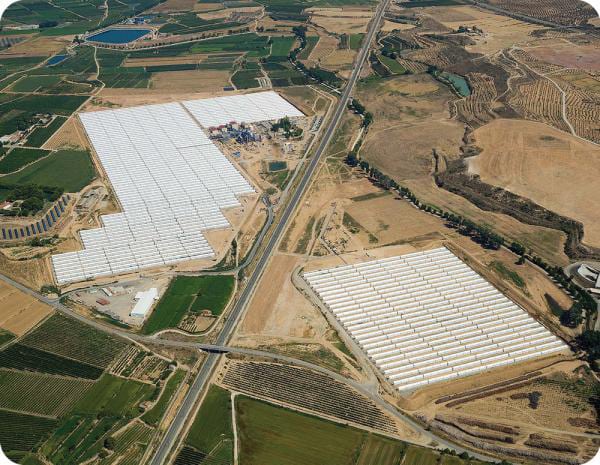 |
| 2. Mixed greens. The Termosolar Borges plant near Barcelona, Spain, combines biomass and concentrating solar power. Courtesy: Abantia |
Another CSP-biomass hybrid plant came online in Italy in 2014 as the result of a CSP retrofit to an existing biomass plant. The 14-MW Rende project in Calabria, Italy, operated by Falck Renewables, was originally built in 2000. A 1-MW Fresnel-type CSP system was added last year.
A number of other such plants have been proposed in the U.S., India, and North Africa, but so far none are online.
Solar + Geothermal: Clean Steam
Geothermal generation offers much the same synergy for solar as does natural gas, except that it requires no fuel and produces no emissions. The drawback is that such hybrid systems are limited to areas where both geothermal resources are available and there is sufficient solar irradiation. Fortunately, a number of such locations exist across the western U.S. and other areas.
The first, and so far largest geothermal-solar hybrid facility is the Stillwater plant in Fallon, Nev., (a 2012 POWER Top Plant) which came online in May 2012. Owned and operated by Enel Green Power North America, Stillwater combines a 33-MW geothermal plant with 26 MW of solar photovoltaic (PV) panels.
The combination achieves several synergies. The geothermal system is at its lowest efficiency during the middle of the day (when its air-cooled condensers struggle with the ambient heat), the same period that the PV panels are at their highest output. Conversely, the system is at its highest efficiency during cool nighttime hours when the solar panels are offline. The combination allows the plant to stabilize its production and achieve a more load-following profile.
In 2014, Stillwater boosted its capacity by adding an adjacent CSP field, supplied by SkyFuel, which is integrated with the geothermal system. Heat from the CSP system—about 17 MWt—is added to the geothermal brine before it enters the organic Rankine cycle generators. This combination increases the efficiency and stability of the geothermal cycle, and boosts total power output by about 2 MW. Using a common control system and other equipment resulted in substantial savings compared to a standalone CSP system: Adding the CSP generation to Stillwater cost only around $15 million.
Solar + Hydro: Rare
At least one solar-hydro hybrid system is in operation—one that is arguably the largest hybrid plant in the world—a 320-MW solar plant having been added to the existing 1.28-GW Longyangxia hydroelectric station in Qinghai Province in central China. Though very little information is available about the project, the solar farm apparently came online in 2013, though the dam has been operating since 1992.
Solar + Wind: All Clear
The response from renewable energy advocates to criticisms of intermittent output has often been that the intermittencies of wind and solar generation tend to cancel each other out, at least in theory. Solar output is highest during the middle of the day, while wind generation tends to peak during the night. This synergy, however, can be reduced if the two resources are widely separated such that grid operators must still work to balance the competing outputs across the grid.
Co-locating wind and solar generation could allow plant operators to control intermittency at the source, greatly reducing the burdens on the grid. A 2013 study conducted by the Reiner Lemoine Institute in Berlin and Solarpraxis found that combining wind and solar generation on the same site can result in up to twice the amount of electricity being generated across the same surface area, with the shading effects of the turbines found to be minimal (Figure 3).
“The fact that wind and photovoltaic power supply the grid with much more stable levels of energy when working together has a positive effect on grid stability,” Christian Breyer, managing director of the Reiner Lemoine Institute said when the study was released.
All this being said, however, most such facilities remain on the drawing board because of the need for favorable locations. One operating example is EDF Renewables’ 143-MW Catalina Solar Project and 140-MW Pacific Wind Project outside Lancaster, Calif., which leverages the region’s nexus of ample wind resources, extensive insolation, and policy support. The wind farm was completed in 2012; the solar plant reached full operation in 2013. Though built as separate projects, the two plants are about a mile apart and share electrical and transmission infrastructure. According to EDF, the combined operation results in power output around 50% to 60% of the time compared to 35% to 40% from either plant operating alone.
Wind + Hydropower: Full Coverage
Pumped storage hydroelectric generation is a resource that is tailor-made for pairing with renewable generation. One such example currently exists on the Spanish island of El Hierro in the Canaries (see “A Spanish Island’s 100% Wind-and-Water Power Solution” in the August 2014 issue). There, an 11.5-MW wind farm and an 11-MW pumped storage hydropower plant provide the island with 100% renewable energy. When there is excess generation from the wind turbines, the electricity is used to pump water from a lower reservoir 700 m uphill to an upper reservoir. When demand exceeds what the wind turbines can provide, water is released and run back through the pump turbines.
The system, which came online in 2014, frees the island from dependence on expensive imported fuel oil, the bane of many an island grid. The project has been successful enough that feasibility studies are being conducted for other islands in the European Union such as Crete and Madeira.
Morocco is reportedly developing a 1-GW wind-hydro hybrid plant, but it is unclear how far along this project is.
Future Outlook
Though some of these projects and combinations show considerable promise, the hybrid plant sector is still in its infancy and still experiencing growing pains. The synergies and complementary technologies of gas and CSP, not to mention the substantial expense of standalone CSP plants, is likely to mean that ISCC will continue its lead for the foreseeable future. Geographical challenges of other types of hybrids, such as those including geothermal and hydro, may limit their adoption. Still, the potential that hybrid plants offer in managing renewable intermittency means that they are likely to draw increasing attention as the proportion of renewable generation continues to grow. ■
— Thomas W. Overton, JD is a POWER associate editor.


